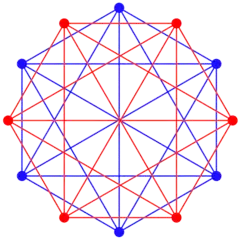| 5-simplex Hexateron (hix) | ||
|---|---|---|
| Type | uniform 5-polytope | |
| Schläfli symbol | {34} | |
| Coxeter diagram | ||
| 4-faces | 6 | 6 {3,3,3} |
| Cells | 15 | 15 {3,3} |
| Faces | 20 | 20 {3} |
| Edges | 15 | |
| Vertices | 6 | |
| Vertex figure | 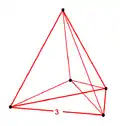 5-cell | |
| Coxeter group | A5, [34], order 720 | |
| Dual | self-dual | |
| Base point | (0,0,0,0,0,1) | |
| Circumradius | 0.645497 | |
| Properties | convex, isogonal regular, self-dual | |
In five-dimensional geometry, a 5-simplex is a self-dual regular 5-polytope. It has six vertices, 15 edges, 20 triangle faces, 15 tetrahedral cells, and 6 5-cell facets. It has a dihedral angle of cos−1(1/5), or approximately 78.46°.
The 5-simplex is a solution to the problem: Make 20 equilateral triangles using 15 matchsticks, where each side of every triangle is exactly one matchstick.
Alternate names
It can also be called a hexateron, or hexa-5-tope, as a 6-facetted polytope in 5-dimensions. The name hexateron is derived from hexa- for having six facets and teron (with ter- being a corruption of tetra-) for having four-dimensional facets.
By Jonathan Bowers, a hexateron is given the acronym hix.[1]
As a configuration
This configuration matrix represents the 5-simplex. The rows and columns correspond to vertices, edges, faces, cells and 4-faces. The diagonal numbers say how many of each element occur in the whole 5-simplex. The nondiagonal numbers say how many of the column's element occur in or at the row's element. This self-dual simplex's matrix is identical to its 180 degree rotation.[2][3]
Regular hexateron cartesian coordinates
The hexateron can be constructed from a 5-cell by adding a 6th vertex such that it is equidistant from all the other vertices of the 5-cell.
The Cartesian coordinates for the vertices of an origin-centered regular hexateron having edge length 2 are:
The vertices of the 5-simplex can be more simply positioned on a hyperplane in 6-space as permutations of (0,0,0,0,0,1) or (0,1,1,1,1,1). These construction can be seen as facets of the 6-orthoplex or rectified 6-cube respectively.
Projected images
| Ak Coxeter plane |
A5 | A4 |
|---|---|---|
| Graph | 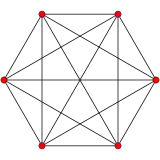 |
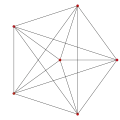 |
| Dihedral symmetry | [6] | [5] |
| Ak Coxeter plane |
A3 | A2 |
| Graph | 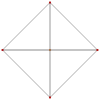 |
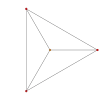 |
| Dihedral symmetry | [4] | [3] |
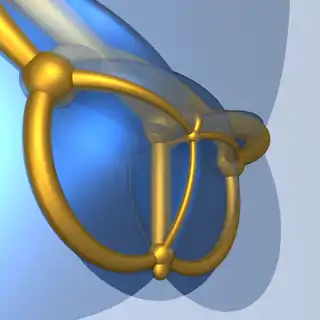 Stereographic projection 4D to 3D of Schlegel diagram 5D to 4D of hexateron. |
Lower symmetry forms
A lower symmetry form is a 5-cell pyramid {3,3,3}∨( ), with [3,3,3] symmetry order 120, constructed as a 5-cell base in a 4-space hyperplane, and an apex point above the hyperplane. The five sides of the pyramid are made of 5-cell cells. These are seen as vertex figures of truncated regular 6-polytopes, like a truncated 6-cube.
Another form is {3,3}∨{ }, with [3,3,2,1] symmetry order 48, the joining of an orthogonal digon and a tetrahedron, orthogonally offset, with all pairs of vertices connected between. Another form is {3}∨{3}, with [3,2,3,1] symmetry order 36, and extended symmetry [[3,2,3],1], order 72. It represents joining of 2 orthogonal triangles, orthogonally offset, with all pairs of vertices connected between.
The form { }∨{ }∨{ } has symmetry [2,2,1,1], order 8, extended by permuting 3 segments as [3[2,2],1] or [4,3,1,1], order 48.
These are seen in the vertex figures of bitruncated and tritruncated regular 6-polytopes, like a bitruncated 6-cube and a tritruncated 6-simplex. The edge labels here represent the types of face along that direction, and thus represent different edge lengths.
The vertex figure of the omnitruncated 5-simplex honeycomb, ![]()
![]()
![]()
![]()
![]()
![]()
![]() , is a 5-simplex with a petrie polygon cycle of 5 long edges. It's symmetry is isomophic to dihedral group Dih6 or simple rotation group [6,2]+, order 12.
, is a 5-simplex with a petrie polygon cycle of 5 long edges. It's symmetry is isomophic to dihedral group Dih6 or simple rotation group [6,2]+, order 12.
| Join | {3,3,3}∨( ) | {3,3}∨{ } | {3}∨{3} | { }∨{ }∨{ } | |
|---|---|---|---|---|---|
| Symmetry | [3,3,3,1] Order 120 | [3,3,2,1] Order 48 | [[3,2,3],1] Order 72 | [3[2,2],1,1]=[4,3,1,1] Order 48 | ~[6] or ~[6,2]+ Order 12 |
| Diagram | 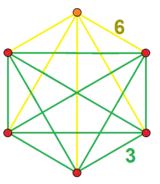 |
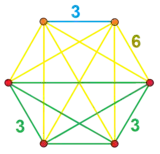 |
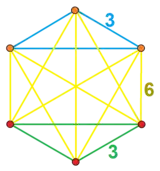 |
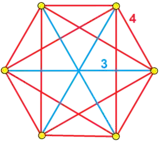 |
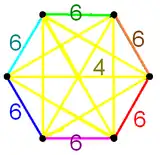 |
| Polytope | truncated 6-simplex |
bitruncated 6-simplex |
tritruncated 6-simplex |
3-3-3 prism |
Omnitruncated 5-simplex honeycomb |
Compound
The compound of two 5-simplexes in dual configurations can be seen in this A6 Coxeter plane projection, with a red and blue 5-simplex vertices and edges. This compound has [[3,3,3,3]] symmetry, order 1440. The intersection of these two 5-simplexes is a uniform birectified 5-simplex. ![]()
![]()
![]()
![]()
![]() =
= ![]()
![]()
![]()
![]()
![]() ∩
∩ ![]()
![]()
![]()
![]()
![]() .
.
Related uniform 5-polytopes
It is first in a dimensional series of uniform polytopes and honeycombs, expressed by Coxeter as 13k series. A degenerate 4-dimensional case exists as 3-sphere tiling, a tetrahedral hosohedron.
| Space | Finite | Euclidean | Hyperbolic | |||
|---|---|---|---|---|---|---|
| n | 4 | 5 | 6 | 7 | 8 | 9 |
| Coxeter group |
A3A1 | A5 | D6 | E7 | =E7+ | =E7++ |
| Coxeter diagram |
||||||
| Symmetry | [3−1,3,1] | [30,3,1] | [31,3,1] | [32,3,1] | [[33,3,1]] | [34,3,1] |
| Order | 48 | 720 | 23,040 | 2,903,040 | ∞ | |
| Graph |  |
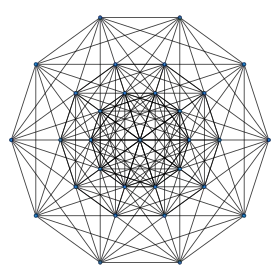 |
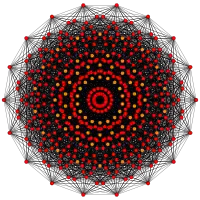 |
- | - | |
| Name | 13,-1 | 130 | 131 | 132 | 133 | 134 |
It is first in a dimensional series of uniform polytopes and honeycombs, expressed by Coxeter as 3k1 series. A degenerate 4-dimensional case exists as 3-sphere tiling, a tetrahedral dihedron.
| Space | Finite | Euclidean | Hyperbolic | |||
|---|---|---|---|---|---|---|
| n | 4 | 5 | 6 | 7 | 8 | 9 |
| Coxeter group |
A3A1 | A5 | D6 | E7 | =E7+ | =E7++ |
| Coxeter diagram |
||||||
| Symmetry | [3−1,3,1] | [30,3,1] | [[31,3,1]] = [4,3,3,3,3] |
[32,3,1] | [33,3,1] | [34,3,1] |
| Order | 48 | 720 | 46,080 | 2,903,040 | ∞ | |
| Graph |  |
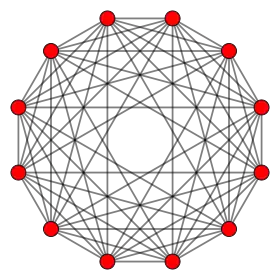 |
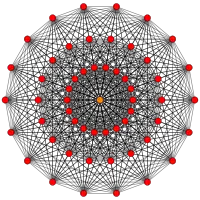 |
- | - | |
| Name | 31,-1 | 310 | 311 | 321 | 331 | 341 |
The 5-simplex, as 220 polytope is first in dimensional series 22k.
| Space | Finite | Euclidean | Hyperbolic | ||
|---|---|---|---|---|---|
| n | 4 | 5 | 6 | 7 | 8 |
| Coxeter group |
A2A2 | A5 | E6 | =E6+ | E6++ |
| Coxeter diagram |
|||||
| Graph |  |
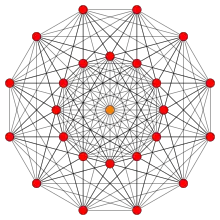 |
∞ | ∞ | |
| Name | 22,-1 | 220 | 221 | 222 | 223 |
The regular 5-simplex is one of 19 uniform polytera based on the [3,3,3,3] Coxeter group, all shown here in A5 Coxeter plane orthographic projections. (Vertices are colored by projection overlap order, red, orange, yellow, green, cyan, blue, purple having progressively more vertices)
| A5 polytopes | |||||||||||
|---|---|---|---|---|---|---|---|---|---|---|---|
 t0 |
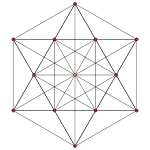 t1 |
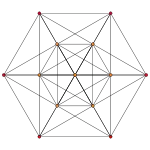 t2 |
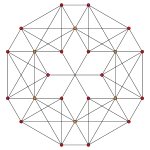 t0,1 |
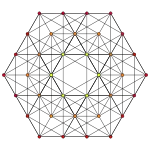 t0,2 |
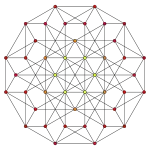 t1,2 |
 t0,3 | |||||
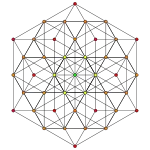 t1,3 |
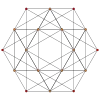 t0,4 |
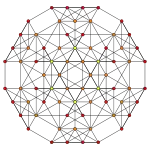 t0,1,2 |
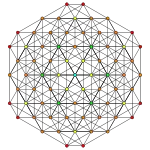 t0,1,3 |
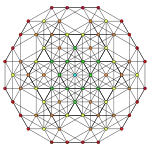 t0,2,3 |
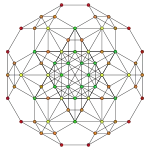 t1,2,3 |
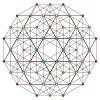 t0,1,4 | |||||
 t0,2,4 |
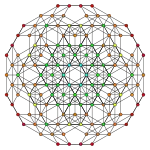 t0,1,2,3 |
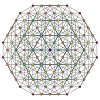 t0,1,2,4 |
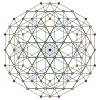 t0,1,3,4 |
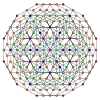 t0,1,2,3,4 | |||||||
See also
Notes
- ↑ Klitzing, Richard. "5D uniform polytopes (polytera) x3o3o3o3o — hix".
- ↑ Coxeter 1973, §1.8 Configurations
- ↑ Coxeter, H.S.M. (1991). Regular Complex Polytopes (2nd ed.). Cambridge University Press. p. 117. ISBN 9780521394901.
References
- Gosset, T. (1900). "On the Regular and Semi-Regular Figures in Space of n Dimensions". Messenger of Mathematics. Macmillan. pp. 43–.
- Coxeter, H.S.M.:
- — (1973). "Table I (iii): Regular Polytopes, three regular polytopes in n-dimensions (n≥5)". Regular Polytopes (3rd ed.). Dover. pp. 296. ISBN 0-486-61480-8.
- Sherk, F. Arthur; McMullen, Peter; Thompson, Anthony C.; Weiss, Asia Ivic, eds. (1995). Kaleidoscopes: Selected Writings of H.S.M. Coxeter. Wiley. ISBN 978-0-471-01003-6.
- (Paper 22) — (1940). "Regular and Semi Regular Polytopes I". Math. Zeit. 46: 380–407. doi:10.1007/BF01181449. S2CID 186237114.
- (Paper 23) — (1985). "Regular and Semi-Regular Polytopes II". Math. Zeit. 188 (4): 559–591. doi:10.1007/BF01161657. S2CID 120429557.
- (Paper 24) — (1988). "Regular and Semi-Regular Polytopes III". Math. Zeit. 200: 3–45. doi:10.1007/BF01161745. S2CID 186237142.
- Conway, John H.; Burgiel, Heidi; Goodman-Strass, Chaim (2008). "26. Hemicubes: 1n1". The Symmetries of Things. p. 409. ISBN 978-1-56881-220-5.
- Johnson, Norman (1991). "Uniform Polytopes" (Manuscript). Norman Johnson.
- Johnson, N.W. (1966). The Theory of Uniform Polytopes and Honeycombs (PhD). University of Toronto.
External links
- Olshevsky, George. "Simplex". Glossary for Hyperspace. Archived from the original on 4 February 2007.
- Polytopes of Various Dimensions, Jonathan Bowers
- Multi-dimensional Glossary
